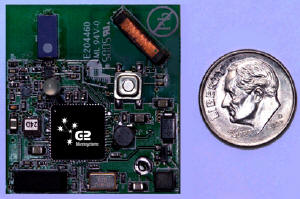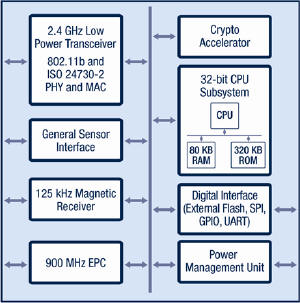408 Euclid Avenue
Oakland, CA 94610
408-323-1404
G2 Microsystems System-on-Chip is a comprehensive approach to tag technology that combines traditional RFID with Wi-Fi and extends the possibilities to sensors and custom applications in a single device that also has very low power consumption. It is much more than an RFID tag because it will traverse being read by an RFID reader and also connect directly to a Wi-Fi network. It can work in contiguous or non-contiguous environments.
 |
The small size is important, but what is more interesting is the architecture because it identifies the flexibility of this product.
 |
Tag Architecture
In the image above note the component blocks, on the left-hand side, are the 2.4 GHz radio and RFID sections. The general sensor interface, on the right-hand side, includes the crypto accelerator, a 32 bit processor, a digital interface and the power management section.
Wi-Fi
The 2.4 GHz radio section supports both Wi-Fi RSSI (a measure of signal strength in a wireless environment) and ISO 24730-2 standards for location using TDOA (Time Difference on Arrival – a form of position determination based on the arrival time of a signal at several sensors – see this description from ERA, or this Master's thesis by Muhammad Aatique, Virginia PolyTech for more information on TDOA ). It involves measuring the time difference when a signal arrives at the sensor or receiver points from source.
The Wi-Fi section has a pre-programmed MAC address (a unique identifier used in networking equipment) which serves as the unique ID for both location and tag identification.
Because of the common bus and RFID extensions, this tag can move between environments (e.g. Wi-Fi to RFID) seamlessly, maintaining a commonality of information, product codes, updates, etc., to a central control point. It can be attached to a pallet of product, report in through RFID, and then continue the linkage through the environment’s Wi-Fi network.
900 MHz EPC
The 900 MHz EPC (Electronic Product Code) section can be configured for various markets and appropriate frequencies. It support data transfer rates of up to 80 kbps (kilobytes per second). This section is passive and while interactive with the rest of the circuitry (common bus), can operate autonomously. It can be reprogrammed on the fly.
125 KHz Magnetic Receiver
The 125 KHz part of the tag circuitry is for close proximity RFID readers and supports data transfer rates of 2 kbps. It also acts autonomously. However, this section can also be reprogrammed on the fly. Magnetic in this case, it refers to the method of signal propagation (tag becomes active when within the reader’s field of radiation), rather than the effects of traditional magnetism or being magnetic itself. Magnetic interfaces have much more predictable behavior and are more reliable than radiated interfaces such as EPC.
General Sensor Interface
The general sensor interface allows the device to be used as part of a sensor network, telemetry source, etc. Typical applications might be to detect temperature, humidity, shock pressure, motion, light or radiation or to be used as a security sensor.
Crypto Accelerator
The Crypto Accelerator is for 802.11 security applications (for the Wi-Fi section) and supports 64 and 128 bit encryption for protection of contained data and access to secure Wi-Fi networks.
32 Bit CPU
The tag has a 32-bit CPU and while the 320 kb ROM contains the operating system, communication protocols (TCP/IP, etc), the 80 kb of RAM is expandable for more instructions, specialized programming, etc.
Digital Interface
There is a digital interface to accommodate additional memory (Flash, RAM) UART (Universal Asynchronous Receiver/Transmitter) and other digital connectivity. It is a 10 pin general purpose input/output port.
Power Management Unit
This section controls the energy flow to the entire circuit. It contains a real-time clock so it can be set to wake up at a given time or periodically perform a function or set of instructions.
This tag is one of the most versatile on the planet. It can use all three receivers on board for both location determination and typical RFID applications. In addition, it comes with a 32-bit processor, expandable memory, two interfaces, digital and analog, so it can be used with typical GPS chips, and with all kinds of sensors. It can even be set up to sample on predetermined schedules.
Because of this versatility, it is only a generation or two away from becoming smarter, even more versatile and even smaller. The cost today is $12 in volume, enabling active tags for $20. This is not a single use device, to be discarded when whatever it is attached to arrives at the warehouse. Because it is designed for an external power source, it could be in service for years, doing all kinds of odd jobs, making the initial cost a non-limiting factor.